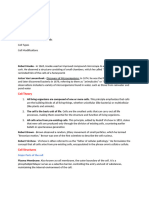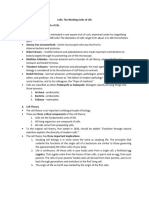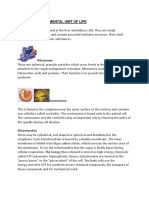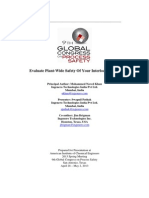Gen Bio1 NOTES 1
Gen Bio1 NOTES 1
Uploaded by
yaphets0116Copyright:
Available Formats
Gen Bio1 NOTES 1
Gen Bio1 NOTES 1
Uploaded by
yaphets0116Original Title
Copyright
Available Formats
Share this document
Did you find this document useful?
Is this content inappropriate?
Copyright:
Available Formats
Gen Bio1 NOTES 1
Gen Bio1 NOTES 1
Uploaded by
yaphets0116Copyright:
Available Formats
Gen Bio1 NOTES
Cell Theory
The cell theory is a fundamental principle in biology that describes the properties and functions of cells. It consists of
three main parts:
1. All living organisms are composed of cells. This means that cells are the basic building blocks of all life forms,
from single-celled organisms to complex multicellular organisms.
2. The cell is the basic unit of structure and organization in organisms. Cells are the smallest units that can carry
out all the processes necessary for life, such as metabolism and reproduction.
3. All cells arise from pre-existing cells. This means that new cells are produced by the division of existing cells,
rather than forming spontaneously.
First Postulate
Cork of Hooke - cytoplasm had already dissipated, indicating the cell’s death
Teeth scraping of Leeuwenhooek – found animalcules shooting and spinning inside the cell.
Second Postulate
Matthias Jacob Schleiden (1838) – small compartments in his plant specimens are cells
Theodore Schwann (1839) – proposed that all animals are made up of cells
Third Postulate
Rudolf Virchow (1855) – introduced 3rd tenet of the cell theory: omnis cellula e cellula means “cells come
from pre-existing cells
Development of cell theory
Marcello Malpighi and Nenemiah Grew (1665-1676) – determined the presence of organelles within its
cells
Jan Evangelista Purkenji (1787 – 1869) – gave the name protoplasm, the colloidal substance in the cell
Roberts brown (1831) – discovered cell organelles – nucleus of the cell
Albrecht Von Roelliker (1840) – stated that sperm and egg are composed of cells
Louis Pasteur (1849) – developed fermentation – process to kill bacteria
Cell History (People)
• Hans and Zacharias Janssen (1590)
- Father and son from German. Placed two spectacle lenses into a tube that leads to the 1 st compound
microscope.
• Robert Hooke (1665)
- 1665 discovered the cell through a thin slice of cork which he compared to a cellulae
• Anton/Antoni/Antoine Van Leeuwenhoek
- Father of microbiology
- Examined diff. subjects using compound microscope
- 1676 – bacteria in water
Spontaneous Generation – belief that living things could spontaneously arise from non-living material.
Major Parts of the Cell
1. Plasma Membrane – separates the cell’s interior from its environment
- Encloses and safeguards organelles from possible harm
- Control’s the exchange of essential components from other cells
Components:
1. Phospolipids – made of glycerol, two fatty acid tails, and phosphate-linked head group
Phospolipid Bilayer – 2 layer of phospholipids with its tail pointing upward
2. Cholesterol - four fused carbon rings
2. Proteins – move large molecules or aid in cell recognition
Peripheral proteins – attached on the surface (inner-outer)
Integral proteins – embedded through membrane
3. Nucleus – discovered by Robert Brown 1833
- Control center most vital part of the cell
- Nucleolus – site of ribosomes synthesis
Cell Organelles
1. Nucleus: The control center of the cell, containing genetic material (DNA). It regulates gene expression and
mediates the replication of DNA during the cell cycle.
2. Mitochondria: Often referred to as the "powerhouses" of the cell, mitochondria generate ATP (adenosine
triphosphate), which is used as a source of chemical energy.
3. Endoplasmic Reticulum (ER):
o Rough ER: Studded with ribosomes and involved in protein synthesis and processing.
o Smooth ER: Lacks ribosomes and is involved in lipid synthesis and detoxification.
4. Golgi Apparatus: Modifies, sorts, and packages proteins and lipids for secretion or delivery to other organelles.
5. Ribosomes: The sites of protein synthesis, found either floating freely in the cytoplasm or attached to the rough
ER.
6. Lysosomes: Contain digestive enzymes that break down waste materials and cellular debris.
7. Peroxisomes: Contain enzymes that help in the breakdown of fatty acids and the detoxification of harmful
substances.
8. Cytoskeleton: A network of protein fibers (microfilaments, intermediate filaments, and microtubules) that
provides structural support, shape, and movement to the cell.
9. Cell Membrane: A lipid bilayer with embedded proteins that regulates the movement of substances into and out
of the cell.
10. Vacuoles: Membrane-bound sacs that store nutrients, waste products, and help maintain turgor pressure in plant
cells.
11. Chloroplasts: Found in plant cells and some algae, chloroplasts are responsible for photosynthesis, the process of
converting sunlight into chemical energy.
12. Centrosomes: found in eukaryotic cells, assist in arranging microtubules
Eukaryotic Cells:
Have a nucleus.
Contain membrane-bound organelles (e.g., mitochondria, ER, Golgi apparatus).
Larger in size (10–100 micrometers).
DNA is linear and contained within the nucleus.
Often multicellular (e.g., plants, animals, fungi).
Undergo mitosis for cell division.
Prokaryotic Cells:
No nucleus, DNA floats freely in the cytoplasm.
Lack membrane-bound organelles.
Smaller in size (1–10 micrometers).
DNA is circular.
Typically unicellular (e.g., bacteria, archaea).
Reproduce through binary fission.
Both (Shared Characteristics):
Have cell membranes.
Contain ribosomes (although structurally different).
Have cytoplasm.
Use DNA as genetic material.
Perform metabolism and other life processes.
Cell types nb
Cell specialization nb
Phases of the Cell Cycle
Mitosis
1. Interphase: This is the phase where the cell spends most of its life. Interphase is divided into three sub-phases:
o G1 Phase (Gap 1): The cell grows in size, synthesizes proteins, and produces RNA. This phase focuses
on normal cell functions and preparation for DNA replication.
o S Phase (Synthesis): DNA replication occurs, resulting in the duplication of chromosomes. Each
chromosome now consists of two sister chromatids connected at the centromere.
o G2 Phase (Gap 2): The cell continues to grow and produces proteins and organelles required for cell
division. The cell checks for any DNA replication errors and prepares for mitosis.
2. M Phase (Mitosis): This is the phase where the cell actually divides. Mitosis is further divided into several
stages:
o Prophase: Chromosomes condense and become visible. The nuclear envelope begins to break down, and
the mitotic spindle (a structure made of microtubules) starts to form.
o Metaphase: Chromosomes line up along the equatorial plane (metaphase plate) of the cell. The spindle
fibers attach to the centromeres of the chromosomes.
o Anaphase: The sister chromatids are pulled apart towards opposite poles of the cell as the spindle fibers
shorten.
o Telophase: The chromatids reach the poles of the cell and begin to de-condense back into chromatin. The
nuclear envelope reforms around each set of chromosomes, resulting in two distinct nuclei.
3. Cytokinesis: This is the final step where the cytoplasm of the cell divides, resulting in two separate daughter
cells. In animal cells, cytokinesis occurs through a process called cleavage furrow formation, while in plant cells,
a cell plate forms to separate the daughter cells.
Meiosis
- Chromosome no. of daughter cell is reduced into half (four haploid daughter cells)
Meiosis 1 – 2 daughter cells
Prophase 1:
Leptotene – same sa prophase of mito
Zygotene – synpsis occurs forming tetrads
Pachytene – crossing over
Diplotene – disintegration of nuclear membrane
Diakinesis – formation of spindle fiber
Metaphase 1 - nuclear membrane completely disintegrated
- Spindle fibers attached to the tetrads
- Tetrads move to metaphase plate
Anaphase 1 – chromosomes move from the center to opposite poles
Telophase 1 – cytoplasm divide, nuclear membrane is formed
Cytokinesis 1 – cytoplasm split into 2, making 2 cells (46n)
Meiosis 2 – sister chromatids of each chromosomes separate
• Prophase II – same sa mitotic phase of prophase except it contains haploid chromosomes
• Metaphase II – formation of spindle fibers
- Chromosome aligned at the metaphase plate
• Anaphase II – daughter chromosomes moves towards the opposite poles
• Telophase II – reappearance of nuclear envelope
- formation of 4 haploid daughter cells
• Cytokinesis – cytoplasm of cell split into two, making 4 new cells (23n)
Tetrads - 4 chromosomes
Regulation of the Cell Cycle
The cell cycle is tightly regulated by various checkpoints and proteins to ensure proper division and function:
1. G1 Checkpoint: Checks for cell size, nutrients, growth factors, and DNA damage before entering the S
phase.Geb BIO
2. G2 Checkpoint: Ensures that DNA has been replicated correctly and that there are no errors before proceeding to
mitosis.
3. M Checkpoint: Monitors the alignment of chromosomes on the metaphase plate and ensures that all
chromosomes are properly attached to the spindle fibers before anaphase begins.
Key Regulatory Proteins
Cyclins: Proteins that regulate the progression of the cell cycle by activating cyclin-dependent kinases (CDKs).
Cyclin-Dependent Kinases (CDKs): Enzymes that, when activated by cyclins, drive the cell cycle forward.
Tumor Suppressor Proteins: Such as p53, which can halt the cell cycle if DNA damage is detected.
Passive Transport
Passive transport does not require energy input from the cell. Substances move across the cell membrane along their
concentration gradient (from high to low concentration). Types of passive transport include:
1. Simple Diffusion:
o Description: Movement of small, nonpolar molecules (like oxygen, carbon dioxide) directly through the
lipid bilayer.
o Example: Oxygen entering cells and carbon dioxide leaving cells.
2. Facilitated Diffusion:
o Description: Movement of larger or polar molecules (like glucose or ions) through specific membrane
proteins (transporters or channels) without energy input.
3. Osmosis:
o Description: A special case of facilitated diffusion involving water molecules. Water moves through
selective permeable membranes via water channels called aquaporins.
Active Transport
Active transport requires energy, usually in the form of ATP, to move substances against their concentration gradient
(from low to high concentration). Types of active transport include:
1. Primary Active Transport:
o Description: Direct use of energy (typically ATP) to transport molecules against their gradient via
specific pumps.
2. Secondary Active Transport (Cotransport):
o Description: Utilizes the energy from primary active transport indirectly. It involves the movement of
one substance down its gradient to drive the movement of another substance against its gradient.
3. Bulk Transport (Vesicular Transport):
o Description: Transport of large quantities of substances or large particles via vesicles. This process
requires energy.
o Types:
Endocytosis: The cell membrane engulfs external materials to form a vesicle and brings them
into the cell. Types include:
Phagocytosis: Engulfing large particles or cells (e.g., white blood cells eating bacteria).
Pinocytosis: Engulfing extracellular fluid and dissolved substances
Exocytosis: Vesicles containing cellular products or waste merge with the plasma membrane to
release their contents outside the cell (e.g., neurotransmitter release from neurons).
Transport mechanisms are essential for various cellular functions, including:
Nutrient Acquisition: Cells need to import essential nutrients and ions.
Waste Removal: Cells must expel metabolic waste products and toxins.
Homeostasis: Maintaining the proper internal environment by regulating ion concentrations and water balance.
Cell Communication: Transport mechanisms play a role in the signaling pathways and interactions between
cells.
Hypertonic Solution:
A hypertonic solution has a higher concentration of solutes (such as salt or sugar) compared to the inside of the
cell.
Water will move out of the cell into the surrounding solution to balance the concentration.
As a result, the cell will shrink or become dehydrated
Isotonic Solution:
An isotonic solution has the same concentration of solutes as inside the cell.
Water moves equally in and out of the cell, so there is no net movement of water.
The cell maintains its normal shape and size in an isotonic environment.
Hypotonic Solution:
A hypotonic solution has a lower concentration of solutes compared to the inside of the cell.
Water will move into the cell from the surrounding solution.
As a result, the cell will swell and may even burst (this is called lysis in animal cells and turgid in plant cells,
where the cell wall prevents bursting)
Diffusion:
Diffusion is the movement of particles (such as molecules or ions) from an area of higher concentration to an
area of lower concentration.
It occurs passively, meaning it does not require energy.
Osmosis:
Osmosis is a specific type of diffusion, where water molecules move from an area of lower solute
concentration (or higher water concentration) to an area of higher solute concentration (or lower water
concentration) through a semi-permeable membrane.
Like diffusion, it is a passive process and does not require energy.
The goal of osmosis is to balance the concentration of solutes on both sides of the membrane.
Nb at ppt lesson 7
You might also like
- IAS Biology Student Book 1 (2018) AnswersDocument74 pagesIAS Biology Student Book 1 (2018) AnswersGazar76% (33)
- Grade 10 Science NotesDocument43 pagesGrade 10 Science NotesIoana Burtea89% (28)
- First Grading Advance Science Reviewer Grade 7Document7 pagesFirst Grading Advance Science Reviewer Grade 7loraine67% (3)
- Cell Cheat SheetDocument5 pagesCell Cheat SheetAJ Coots100% (3)
- Unit 1: The World of Cell Chapter 1: Introduction To Cell Biology Cell Theory - The Cell Theory Is The Universal For All Living Things, No Matter HowDocument22 pagesUnit 1: The World of Cell Chapter 1: Introduction To Cell Biology Cell Theory - The Cell Theory Is The Universal For All Living Things, No Matter HowCamille BonsayNo ratings yet
- Bio Exam ReviewerDocument10 pagesBio Exam ReviewerMarlon JonasNo ratings yet
- Cell Biology Note 2022Document33 pagesCell Biology Note 2022balikisopeyemi333No ratings yet
- BIOCHEMDocument14 pagesBIOCHEMLyhNo ratings yet
- Chapter 1 GED BioDocument52 pagesChapter 1 GED BioKhant ZawNo ratings yet
- AS Biology: Unit 2 Notes:: The Voice of The GenomeDocument20 pagesAS Biology: Unit 2 Notes:: The Voice of The GenomeAlaska DavisNo ratings yet
- Biology Notes 1st Quarter 1Document27 pagesBiology Notes 1st Quarter 1Janelle Grace OrdanizaNo ratings yet
- Cells and TissuesDocument120 pagesCells and TissueseysabelagwenNo ratings yet
- Biology Unit 2 Revision: Topic 3 - Voice of The GenomeDocument6 pagesBiology Unit 2 Revision: Topic 3 - Voice of The GenomeYasinKureemanNo ratings yet
- Biology Defenition of TermsDocument13 pagesBiology Defenition of TermsJoaquine ArateaNo ratings yet
- Chapter 3Document4 pagesChapter 3Al Cris BarroNo ratings yet
- Science Quiz BeeDocument7 pagesScience Quiz BeerieNo ratings yet
- Nature of CellsDocument7 pagesNature of CellsAdrian Lee VannorsdallNo ratings yet
- Biology Unit 2 NotesDocument21 pagesBiology Unit 2 Notesdimaku100% (8)
- Normal Cell, Adaptation and Cell InjuryDocument77 pagesNormal Cell, Adaptation and Cell Injuryeduviere46No ratings yet
- Bio1 Lesson 1 NotesDocument7 pagesBio1 Lesson 1 Notesykanemoto81No ratings yet
- Unit 2 Study Guide - TeacherDocument11 pagesUnit 2 Study Guide - Teacherapi-198603477No ratings yet
- Gen BioDocument21 pagesGen Biosadangalvin16No ratings yet
- Biology REVIEW FOR CMDocument12 pagesBiology REVIEW FOR CMyangyang804574No ratings yet
- 6CO + 6H O C H O + 6O: Chapter 4: Cells & EnergyDocument7 pages6CO + 6H O C H O + 6O: Chapter 4: Cells & Energyel conejo maloNo ratings yet
- General Biology 1st Quarter ReviewerDocument29 pagesGeneral Biology 1st Quarter ReviewerShania Ashley AmuraoNo ratings yet
- Lecture 1 & 2Document23 pagesLecture 1 & 2yousifshli0No ratings yet
- A1 The Cell 4th EditDocument15 pagesA1 The Cell 4th Editot790953No ratings yet
- General BiologyDocument5 pagesGeneral BiologySpade Obusa100% (1)
- Biology ReviewerDocument6 pagesBiology Reviewerleleidy19emanoNo ratings yet
- Homework 1 &2 Biology IUDocument5 pagesHomework 1 &2 Biology IUVanessa NguyenNo ratings yet
- Lecture 2 CellDocument25 pagesLecture 2 Cellabdelrazeq zarourNo ratings yet
- Isrc 1STDocument5 pagesIsrc 1STaragasimohammadsaif5No ratings yet
- Lesson 1 Cell, Cell Theory, and Cell TypesDocument34 pagesLesson 1 Cell, Cell Theory, and Cell TypesAbubakar DucaysaneNo ratings yet
- Biology For Engineers NOTES For I MIDDocument11 pagesBiology For Engineers NOTES For I MIDmaheshdasari700No ratings yet
- Introduction To Cytology or Cell BiologyDocument63 pagesIntroduction To Cytology or Cell BiologyChemMANo ratings yet
- Biology Midterms 2021Document13 pagesBiology Midterms 2021Keano GelmoNo ratings yet
- Chapter 3Document65 pagesChapter 3Sintayehu Tsegaye100% (1)
- Cell Structure Function and PropertiesDocument10 pagesCell Structure Function and PropertiesWanda JohnNo ratings yet
- Unit 2 (1) 2Document11 pagesUnit 2 (1) 2Johnieer Bassem MoferdNo ratings yet
- Cell Structure and Function3Document15 pagesCell Structure and Function3marklexter.b.bardelosaNo ratings yet
- The Cell Theory of BiologyDocument10 pagesThe Cell Theory of BiologyFrezelVillaBasiloniaNo ratings yet
- Cell DivisionDocument3 pagesCell DivisionAileen TorioNo ratings yet
- Guia de Genetica Etapa 1 y 2 InglesDocument7 pagesGuia de Genetica Etapa 1 y 2 InglesVanessa Gabriela Gámez ÁvilaNo ratings yet
- CellsDocument2 pagesCellseleanorlion34No ratings yet
- Bio Na Di Pa TaposDocument3 pagesBio Na Di Pa Tapos김서연No ratings yet
- Science 8 Q4 L2Document5 pagesScience 8 Q4 L2Sheila mae CadiaoNo ratings yet
- CellDocument21 pagesCellMychelle HidalgoNo ratings yet
- Biology AML NMAT ReviewerDocument15 pagesBiology AML NMAT ReviewerJocelyn Mae CabreraNo ratings yet
- Acad Fall08 ThecellDocument13 pagesAcad Fall08 Thecellhassanmusahassan81No ratings yet
- Cell Growth and DivisionDocument23 pagesCell Growth and DivisionWolfwood ManilagNo ratings yet
- Notes For CH. CellDocument5 pagesNotes For CH. Celladityamanik.121No ratings yet
- Cell-The Fundamental Unit of Life: RibosomesDocument20 pagesCell-The Fundamental Unit of Life: RibosomescbseiscNo ratings yet
- Cell CycleDocument9 pagesCell CycleCrystal Joy RebelloNo ratings yet
- Chapter Ten:: Cell Cycle and Cell DivisionDocument12 pagesChapter Ten:: Cell Cycle and Cell DivisionShivani Shree SundaramoorthyNo ratings yet
- Cell HistoryDocument35 pagesCell Historyhazaleda725No ratings yet
- GEN. ZOO (Midterms)Document8 pagesGEN. ZOO (Midterms)mimiNo ratings yet
- Vacuoles and Vesicles Peroxisomes Centrosomes Cytoskeleton Nucleoid Nucleus Cell Cycle The Cell Cycle Interphase 1Document14 pagesVacuoles and Vesicles Peroxisomes Centrosomes Cytoskeleton Nucleoid Nucleus Cell Cycle The Cell Cycle Interphase 1cfhsmjmdqnNo ratings yet
- The Basics of Cell Life with Max Axiom, Super Scientist: 4D An Augmented Reading Science ExperienceFrom EverandThe Basics of Cell Life with Max Axiom, Super Scientist: 4D An Augmented Reading Science ExperienceNo ratings yet
- Anatomy and Physiology: The Cell and Cell Division: Things You Should Know (Questions and Answers)From EverandAnatomy and Physiology: The Cell and Cell Division: Things You Should Know (Questions and Answers)No ratings yet
- The Cell and Division Biology for Kids | Children's Biology BooksFrom EverandThe Cell and Division Biology for Kids | Children's Biology BooksNo ratings yet
- 04Document3 pages04yaphets0116No ratings yet
- 14444Document4 pages14444yaphets0116No ratings yet
- Quiz2Document2 pagesQuiz2yaphets0116No ratings yet
- 444Document3 pages444yaphets0116No ratings yet
- RISKDocument1 pageRISKyaphets0116No ratings yet
- True or FalseDocument5 pagesTrue or Falseyaphets0116No ratings yet
- ccc10-1 2018 222Document10 pagesccc10-1 2018 222Efari BahcevanNo ratings yet
- H P F L A R e (K - F X - 0 4 3 0 0 1)Document16 pagesH P F L A R e (K - F X - 0 4 3 0 0 1)tariqNo ratings yet
- A New Improved Stability-Indicating RP-HPLC Method For Determination of Diosmin and Hesperidin in CombinationDocument6 pagesA New Improved Stability-Indicating RP-HPLC Method For Determination of Diosmin and Hesperidin in CombinationNisa Azkia FarhanyNo ratings yet
- Evaluate Plant-Wide Safety of Your Interlock SystemDocument14 pagesEvaluate Plant-Wide Safety of Your Interlock SystemnavedscribdNo ratings yet
- Construction SpecificationDocument11 pagesConstruction SpecificationersinNo ratings yet
- Boosting Electrosynthesis of Urea From N2 and CO2 by Defective Cu-BiDocument15 pagesBoosting Electrosynthesis of Urea From N2 and CO2 by Defective Cu-BiCB Dong SuwonNo ratings yet
- OTK - Ekstraksi Cair-Cair Single StageDocument7 pagesOTK - Ekstraksi Cair-Cair Single StageArganesa Erniko PNo ratings yet
- PIR Dämmung - ENDocument2 pagesPIR Dämmung - ENBorisNo ratings yet
- BAM Chapter5 April2023Version 04122023Document33 pagesBAM Chapter5 April2023Version 04122023Im GrootNo ratings yet
- KINIK Catalogue 2018 Us PDFDocument59 pagesKINIK Catalogue 2018 Us PDFAfrianaAghataRahmadiantama0% (1)
- Battery SizingDocument12 pagesBattery SizinghashimelecNo ratings yet
- Heating Catalogue 2019Document44 pagesHeating Catalogue 2019Zoran SimanicNo ratings yet
- Oil and Gas Well Drilling Workers and Services OperatorsDocument7 pagesOil and Gas Well Drilling Workers and Services Operatorsfawad2005No ratings yet
- Fiitjee F Cat SolDocument5 pagesFiitjee F Cat SolAyush SunnyNo ratings yet
- Arc Blow LogoDocument3 pagesArc Blow Logoأحمد حسنNo ratings yet
- 21 CFR Part 50 - Protection of Human SubjectsDocument13 pages21 CFR Part 50 - Protection of Human Subjectsjubin4181No ratings yet
- Chem File AnsersDocument66 pagesChem File Ansershusseinsalma470No ratings yet
- Solid Waste ManagementDocument52 pagesSolid Waste ManagementJinky Faelorca TambasenNo ratings yet
- X CBSE 2016 Science SolutionDocument6 pagesX CBSE 2016 Science SolutionRAJESH KUMARNo ratings yet
- Overview CHRA 3rd Ed-Taklimat Pusat PengajarDocument31 pagesOverview CHRA 3rd Ed-Taklimat Pusat PengajarLuqman Osman100% (3)
- Content / Discussion / Learning Resources / Link: Schedule of Synchronous SessionsDocument22 pagesContent / Discussion / Learning Resources / Link: Schedule of Synchronous SessionsJM OcampoNo ratings yet
- W1 D2 Q1 Gen Chem 1Document8 pagesW1 D2 Q1 Gen Chem 1Raymart Mesuga0% (1)
- Exercise 7 - The Avian EggDocument5 pagesExercise 7 - The Avian EggSebastian SmytheNo ratings yet
- Saudi Aramco Approved Local Manufacturers ListDocument6,650 pagesSaudi Aramco Approved Local Manufacturers ListAzeem Chaudhry59% (17)
- Bunsen Burner & SafteyDocument10 pagesBunsen Burner & SafteyDelano PeteNo ratings yet
- St00502 Basic Chemistry Assignment 1 Answer All of The QuestionsDocument2 pagesSt00502 Basic Chemistry Assignment 1 Answer All of The QuestionsOri LukeNo ratings yet
- Heat Transfer in Freeze-Drying ApparatusDocument25 pagesHeat Transfer in Freeze-Drying Apparatustwintwin91No ratings yet
- AssignmentDocument15 pagesAssignmentIsrat Jahan SurovyNo ratings yet
- Price Schedule Pest LantexDocument11 pagesPrice Schedule Pest LantexMwesigwa DaniNo ratings yet































































































